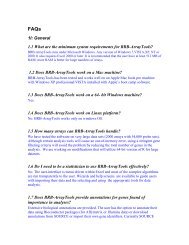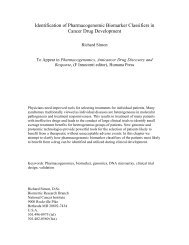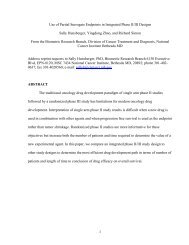Accelerated titration designs - Biometric Research Branch
Accelerated titration designs - Biometric Research Branch
Accelerated titration designs - Biometric Research Branch
You also want an ePaper? Increase the reach of your titles
YUMPU automatically turns print PDFs into web optimized ePapers that Google loves.
94 ACCELERATED TITRATION DESIGNS<br />
4.2.1 Intrapatient dose-escalation<br />
In order to maximize each patient's chance to be treated at a potentially active dose,<br />
the accelerated <strong>titration</strong> design allows intrapatient dose-escalation for a patient who<br />
remains on study and has no evidence of toxicity at the current dose. Specifically,<br />
the dose for the next course is escalated if less than moderate toxicity was observed<br />
for the patient during the current course. If moderate toxicity occured, then the dose<br />
stays the same for the next course for that patient. If DLT occurred, then the patient<br />
generally goes off-study, but if not, then the dose is reduced. For design 2, single-dose<br />
steps are used for intrapatient dose changes. For <strong>designs</strong> 3 and 4, double-dose steps<br />
are used for intrapatient dose changes durng the accelerated stage, and single-dose<br />
steps subsequently.<br />
All four <strong>designs</strong> may be used with and without intrapatient dose-escalation. Simon<br />
et at. (7) compared the performance of the four <strong>designs</strong>, with and without intrapatient<br />
dose-escalation, in terms of toxicity, potential effcacy (reduction of treatment at doses<br />
below the MTD) and tral length. Table 4.1 also summarzes the two intrapatient doseescalation<br />
options.<br />
4.3 Evaluation of performance<br />
Simon et at. (7) fit the above model to data from 20 phase I trals (involving 9 distinct<br />
agents). Only thee ofthe trals showed any evidence of cumulative toxicity (a :: 0).<br />
The estimates of a for the other trals were zero or very close to zero. The trials vared<br />
substantially in the other parameters and thus provide a broad range of experience for<br />
evaluation of the accelerated <strong>titration</strong> <strong>designs</strong>.<br />
Simon et at. (7) evaluated the performance of the accelerated <strong>titration</strong> <strong>designs</strong> by<br />
simulating phase I data based on the 20 sets of parameters estimated from the 20 real<br />
trals that they studied. For each of the 20 sets of parameters, they generated data for<br />
1000 phase I trals and applied each of their <strong>designs</strong> to the simulated data. Figure 4.1<br />
shows the average number of patients per tral utilzed by each of the <strong>designs</strong>. For<br />
each design, the average is taken over the same 20000 simulated datasets generated<br />
from the sets of parameters derived from the 20 actual trals analyzed. Results for<br />
eight <strong>designs</strong> are shown. Designs 1 to 4 are as described above. The <strong>designs</strong> labeled<br />
with B utilize intrapatient dose-escalation if the toxicity in the previous course is less<br />
than intermediate. Designs labeled with A do not permt intrapatient dose-escalation.<br />
Design lA corresponds to the standard design, although it does not use Fibonacci<br />
dose steps. Design lB is the standard design augmented to permt intrapatient doseescalation.<br />
As can be seen in Figure 4.1, the average number of patients is much greater<br />
for the standard design lA or lB than for any of the accelerated <strong>titration</strong> <strong>designs</strong>. The<br />
average number of patients is somewhat less for <strong>designs</strong> 3 and 4 that use doubledose<br />
steps compared to design 2. Although the average differences are not great, the<br />
differences for individual trals can be; i.e. for a tral in which the starng dose is<br />
very low relative to the dose at which intermediate toxicity is expected, <strong>designs</strong> 2<br />
and 3 wil require substantially fewer patients.









